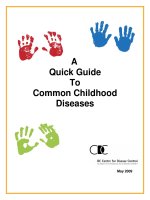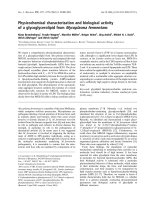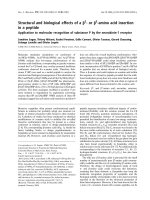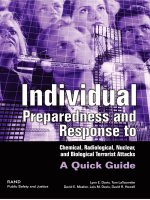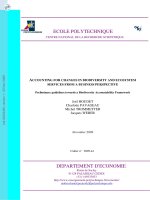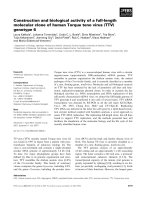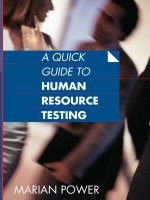Individual Preparedness and Response to Chemical, Radiological, Nuclear, and Biological Terrorist Attacks - A Quick Guide potx
Bạn đang xem bản rút gọn của tài liệu. Xem và tải ngay bản đầy đủ của tài liệu tại đây (1.59 MB, 35 trang )
Individual
Preparedness and
Response to
Chemical, Radiological, Nuclear,
and Biological Terrorist Attacks
Lynn E. Davis, Tom LaTourrette
David E. Mosher, Lois M. Davis, David R. Howell
Supported by the
Alfred P. Sloan Foundation
R
Public Safety and Justice
A Quick Guide
RAND is a nonprofit institution that helps improve policy and
decisionmaking through research and analysis. RAND
®
is a
registered trademark. RAND’s publications do not necessarily reflect
the opinions or policies of its research sponsors.
© Copyright 2003 RAND
All rights reserved. No part of this book may be reproduced in any
form by any electronic or mechanical means (including
photocopying, recording, or information storage and retrieval)
without permission in writing from RAND.
Published 2003 by RAND
1700 Main Street, P.O. Box 2138, Santa Monica, CA 90407-2138
1200 South Hayes Street, Arlington, VA 22202-5050
201 North Craig Street, Suite 202, Pittsburgh, PA 15213
RAND URL: />To order RAND documents or to obtain additional information,
contact Distribution Services: Telephone: (310) 451-7002;
Fax: (310) 451-6915; Email:
ISBN: 0-8330-3487-1
The research described in this report was sponsored by the Alfred P.
Sloan Foundation under Grant No. 2002-10-2. This research was
conducted within RAND’s Public Safety and Justice program.
Cover design by Stephen Bloodsworth
PREFACE
This Quick Guide presents a strategy that individuals
can adopt to prepare for and respond to terrorist
attacks involving chemical, radiological, nuclear, and
biological weapons. The strategy is designed to pro-
vide simple and clear guidance for individuals to help
protect themselves in the event of an actual terrorist
attack, which may involve extremely hazardous and
unfamiliar conditions. Steps that individuals are now
taking or might take to avoid such attacks are not
part of this strategy.
These recommendations emerged from a study
that RAND conducted, under the sponsorship of the
Alfred P. Sloan Foundation, and is fully reported in
Individual Preparedness and Response to Chemical,
Radiological, Nuclear, and Biological Terrorist
Attacks, Santa Monica, Calif.: RAND, MR-1731-SF,
2003.
This study was conducted within RAND’s Public
Safety and Justice program. RAND Public Safety and
Justice conducts research and analysis that helps
inform policymakers and communities in the areas of
public safety, including law enforcement, terrorism
preparedness, immigration, emergency response and
management, and natural disasters; criminal justice,
including sentencing and corrections policy, firearms,
and community violence; and drug policy, which
focuses on problems related to illegal drugs and sub-
stance abuse.
Inquiries about RAND Public Safety and Justice
may be directed to
Jack Riley
RAND Public Safety and Justice
1700 Main Street
Santa Monica, CA 90407-2138
310-393-0411
iii
✺
CONTENTS
Preface . . . . . . . . . . . . . . . . . . . . . . . . . . . . . . iii
Acknowledgments . . . . . . . . . . . . . . . . . . . . . . vii
Introduction . . . . . . . . . . . . . . . . . . . . . . . . . . 1
Recommended Response Strategy:
Chemical Attack . . . . . . . . . . . . . . . . . . . . . . 3
Recommended Response Strategy:
Radiological Attack . . . . . . . . . . . . . . . . . . . 7
Recommended Response Strategy:
Nuclear Attack . . . . . . . . . . . . . . . . . . . . . . . 11
Recommended Response Strategy:
Biological Attack . . . . . . . . . . . . . . . . . . . . . 15
Recommended Response Strategy:
Personal Priorities . . . . . . . . . . . . . . . . . . . . 21
What You Can Do to Prepare Yourself . . . . . . . 23
What Government and Business Can Do . . . . . . 25
v
✺
ACKNOWLEDGMENTS
Many people have participated in this project and
contributed in a variety of ways. We would especial-
ly like to thank our many RAND colleagues. Lisa
Meredith and Terri Tanielian superbly led our focus
group discussions; James T. Quinlivan, John
Parachini, and Greg Jones helped us develop the ter-
rorist scenarios; Charles Meade gave us a thoughtful
review; and Paul Steinberg helped us conceptualize
our effort. Very special thanks go to Phyllis M.
Gilmore, who took up the challenge of translating
our analytical report into this readily understandable
Quick Guide. Thanks also go to Stephen G.
Bloodsworth, whose many talents can be seen in our
cover design and the enclosed reference card, and to
Phillip Wirtz, who carefully proofread the results.
Finally, this report benefited enormously from the
support, counsel, and encouragement of K. Jack
Riley, who leads RAND’s Public Safety and Justice
unit.
vii
✺
INTRODUCTION
There is much the nation must do—and is doing—to
guard against and prepare for terrorist attacks. In
some possible situations, individuals may have to rely
on themselves to protect their own health and
safety—perhaps even their own lives. Thus, individ-
ual preparedness is an important element of our
nation’s strategy for homeland security.
Many people know how to respond in such disas-
ters as fires and earthquakes, but few would know
what to do if someone were to use a chemical, radio-
logical, nuclear, or biological weapon in their vicini-
ty. Although the characteristics of such attacks may
vary widely and their likelihood is highly uncertain,
they can all create unfamiliar and very dangerous cir-
cumstances. Consequently, individuals need an over-
all strategy they can use to prepare for and respond
to such attacks.
This guide emerged from a detailed what-if,
scenario-driven analysis we conducted to examine
four types of terrorist attacks: chemical, radiological,
nuclear, and biological.
1
In each case, the response
strategy is guided by a fundamental objective, which
we refer to as an overarching goal, which in turn
depends on taking certain actions. We have distilled
our findings into this guide to offer individuals a
series of actions they can take to save lives, even in
catastrophic situations.
The actions we present here are appropriate
regardless of the likelihood of an attack, its scale, or
1
✺
1
A related RAND report—Individual Preparedness and
Response to Chemical, Radiological, Nuclear, and Biological
Terrorist Attacs , Santa Monica, Calif.: RAND, MR-1731-SF,
2003 (ISBN 0-8330-3473-1)—describes the supporting analysis
and presents our strategy in greater detail.
2
✺
the current government alert level; they are designed
to be useful over a range of variations in scenarios;
and they have been defined in terms of simple rules
that should be easy to follow. The reference card
included at the back of the guide encapsulates the key
points and can be removed for display in a prominent
place.
Note that any preparedness strategy will need to
be refined and updated continually, as new opportu-
nities for individual preparedness and response
emerge, and to account for the evolving nature of the
terrorist threat.
2
2
The Department of Homeland Security has taken an impor-
tant step in launching the Ready campaign. A description of the
various activities in this campaign can be found on its Web
page: www.ready.gov. We view our recommendations as further
developing these and other recent terrorism preparedness guide-
lines.
RECOMMENDED RESPONSE STRATEGY:
C
HEMICAL ATTACK
Chemical attacks entail the dispersal of chemical
vapors, aerosols, liquids, or solids, and individuals
are affected by inhaling these or being exposed
3
✺
Overarching Goal
Find clean air very quickly.
Specific Actions
1. If attack is outdoors, and you are outdoors,
take shelter quickly in the closest building,
close all windows/doors, and shut off the flow
of air. If inside, stay inside. Then, to the extent
possible, move upstairs, find an interior room,
and seal the room. Remain inside until told it is
safe to leave, and then ventilate and vacate
the shelter immediately.
2. If attack is indoors, follow chemical attack
plans specific to your building. If these are not
available, open windows and breathe fresh
air. If open windows are not accessible,
evacuate (using escape hood if available) by
stairs to street or roof.
3. Once protected from chemical agent exposure,
decontaminate by removing clothes and
showering.
4. When conditions are safe to move about
freely, seek medical treatment.
through their eyes and skin. Terrorists could use any
of numerous chemical agents in an attack, including
both industrial chemicals and chemical warfare
agents. Chemical weapons act very quickly, often
within a few seconds. As a result, government offi-
cials are unlikely to be able to give warning or guid-
ance. Individuals must act almost instantly and on
their own to minimize exposure.
It is critical to know whether the attack has
occurred outdoors or inside a building and to take
action according to where you are in relation to that
release. It is essential to find clean air very quickly.
If the chemical attack is outdoors, and you are out-
doors, take shelter inside and close all doors and win-
dows. If possible, also shut off the airflows. This pro-
vides protection by keeping out the chemical agent.
However, because buildings cannot be sealed off
entirely, you need to vacate the building as soon as it
is safe. Knowing when it is safe will likely require
guidance from emergency officials. Evacuation in
such attacks is not recommended because individuals
cannot determine soon enough where it would be
safe to evacuate to. Neither is using respiratory pro-
tective equipment recommended in an outdoor chem-
ical attack because it would only be effective if put on
within a minute or less, and this is probably not fea-
sible.
Finding clean air is particularly challenging in an
indoor chemical attack, given the variations in venti-
lation systems. Consequently, it is best to follow a
chemical attack response plan designed specifically
for the particular building. This is not always possi-
ble, particularly in unfamiliar buildings. If you do not
know the specific plan for the building, the fastest
way to find clean air is to open a window or door to
4
✺
the outside. If that is not possible, either because the
window or door will not open or none is available,
evacuate the building using the stairs, going either to
the street or, if it is closer and known to be accessible,
to the roof. Because there is a risk that you might
need to move through areas with dangerous concen-
trations of chemical agents, using an emergency
escape hood can make evacuation safer.
3
However,
because escape hoods are expensive and require
advance training, using one may not be an option for
many individuals. You should evacuate the premises
whether you have a hood or not because the alterna-
tive of sheltering in an interior space creates poten-
tially more serious dangers.
Once you have obtained a reliable source of clean
air, your next concern is the residual danger chemical
agents may present. It is thus important to begin per-
sonal decontamination as soon as possible. This
means removing and bagging your clothing and
washing yourself thoroughly with soap and water.
4
Finally, given the range of possible medical effects
of chemical agents, anyone potentially exposed
should also seek medical care.
5
✺
3
An emergency escape hood is a soft-sided pullover hood
with an elastic neck seal. These hoods provide chemical and
biological air filtration for 15 to 60 minutes, enabling the
wearer to exit dangerous environments. Because there is no
face seal, these hoods do not need to be fitted to the individual
and are compatible with eyeglasses and facial hair. Users need
proper training in the use of hoods (as well as with any other
respiratory protection). Escape hoods should only be used
when they have been issued as part of a workplace or other
organizational safety program.
4
Emergency officials will inform you about how you should
treat or dispose of contaminated clothing.
7
✺
RECOMMENDED RESPONSE STRATEGY:
R
ADIOLOGICAL ATTACK
A radiological attack is likely to entail use of what is
often called a “dirty bomb,” in which conventional
explosives are used to disperse radioactive material
quickly across a wide area. Beyond the risk of imme-
diate injury from the explosion itself, the primary ini-
tial danger is inhaling the radioactive material that is
suspended within the dust and smoke from the explo-
Overarching Goal
Avoid inhaling dust that could be radioactive.
Specific Actions
1. If an explosion occurs outdoors or you are
informed of an outside release of radiation
and you are outside, cover nose and mouth
and seek indoor shelter. If you are inside an
undamaged building, stay there. Close
windows and doors and shut down ventilation
systems. Exit shelter when told it is safe.
2. If an explosion occurs inside your building or
you are informed of a release of radiation,
cover nose and mouth and go outside
immediately.
3. Decontaminate by removing clothing and
showering.
4. Relocate outside the contaminated zone, only
if instructed to do so by public officials.
sion. A secondary hazard is the danger that residual
radiation presents for those who remain in the cont-
aminated area for a very long time. In either case, the
levels of radiation will be quite low, so the main con-
cern is an elevated risk of cancer, which will only
manifest itself after many years.
The authorities are unlikely to detect the radiation
immediately, so you will need to be able to respond
on your own, without knowing whether or not
radiation is present. Your primary goal is to avoid
inhaling dust that might be radioactive. Note that,
even though the fact that the dust is radioactive will
not be clear at first, many other types of dust also
present serious health hazards and should likewise be
avoided. So, it is advisable to take the actions we
describe here in case of any explosion.
For an outdoor explosion, if you are outside, take
shelter inside the nearest undamaged building; if you
are inside an undamaged and unthreatened building,
stay there. If the explosion occurs inside your build-
ing, get out. You can further protect yourself by cov-
ering your nose and mouth. A dust mask (one with
an N95-rated particulate filter) would be most help-
ful, but any cloth available will do, such as a shirt.
Immediate evacuation of the area is not recom-
mended, for two reasons. First, you could not evacu-
ate quickly enough to avoid inhaling potentially
radiation-laden dust. Second, you are unlikely to
know where to go to be safe or even how to get there
safely, since you will have little way of knowing the
direction the contaminated dust is moving and where
it is settling.
After safely finding shelter, anyone who might
have been exposed to the radioactive material should
begin to decontaminate themselves immediately. As
8
✺
9
✺
with chemical exposure, this means removing and
bagging your clothing, then washing yourself thor-
oughly with soap and water. You should also seek
medical attention after officials indicate that it is safe
to do so.
Although contamination levels from a radiological
weapon are likely to be quite low, the concern about
the effects of long-term exposure may be great
enough in some areas that authorities will ask you to
leave your home or business for an extended period.
11
✺
RECOMMENDED RESPONSE STRATEGY:
N
UCLEAR
ATTACK
A nuclear detonation will be unmistakable the
moment it occurs: It will be marked by blast effects
strong enough to knock over buildings, a brilliant
flash of light, high-energy radiation, and extreme
Overarching Goal
Avoid radioactive fallout: evacuate the fallout
zone quickly or, if not possible, seek best
available shelter.
Specific Actions
1. Move out of the path of the radioactive fallout
cloud as quickly as possible (less than 10
minutes when in immediate blast zone) and
then find medical care immediately.
2. If it is not possible to move out of the path of
the radioactive fallout cloud, take shelter as far
underground as possible or if underground
shelter is not available, seek shelter in the
upper floors of a multistory building.
3. Find ways to cover skin, nose, and mouth, if it
does not impede either evacuating the area or
taking shelter.
4. Decontaminate as soon as possible, once
protected from the fallout.
5. If outside the radioactive fallout area, still take
shelter to avoid any residual radiation.
12
✺
heat. The explosion will produce a characteristic
mushroom cloud, from which radioactive material
will begin to fall after about 10 to 15 minutes. The
area affected by this fallout will be long (extending
tens of miles downwind) and narrow (spreading only
a few miles). Given the potential destruction and dis-
ruption caused by such an attack, it may take several
days for officials to be able to offer guidance or sup-
port.
Warning about a terrorist nuclear attack is unlike-
ly; hence, there is little chance of protecting yourself
from the immediate blast and radiation effects.
However, even after these immediate effects, a
tremendous hazard will remain from the radioactive
fallout. This fallout is highly lethal. It is thus critical
for your survival to avoid the fallout, either by evac-
uating the fallout zone quickly or by seeking the best
available shelter.
Evacuation—getting completely out of the path of
the radioactive cloud—is a highly effective way to
protect against fallout. But time matters because you
will have less than 10 minutes when in the immediate
blast zone. Because the distance you will need to trav-
el will be relatively short, at most a mile or so, you
will be able to do this by foot. The key to evacuating
quickly is to find the right way out. This requires
effort but is not as difficult as it may seem at first.
The cloud will cover a portion of the blast zone, so
anyone there should move directly away from the
blast center (away from the location of the initial
bright flash and from the greatest damage) until clear.
The approximate location of the rest of the radioac-
tive cloud can be determined by observing the direc-
tion in which the wind is blowing the cloud. You
should move perpendicular to the wind direction
13
✺
until you are out from underneath the cloud. Once
you are out of the fallout zone, you should find med-
ical care immediately.
If evacuation is not possible, you must find appro-
priate shelter immediately. Sheltering from nuclear
fallout requires getting as much solid material (dirt,
concrete, or masonry) and space as possible between
yourself and the radioactive fallout. The best shelter
is deep underground. If you cannot get to an under-
ground shelter before the radioactive fallout begins to
arrive, the next-best shelter would be on the upper
floors of a multistory building (greater than ten sto-
ries), at least three stories below the roof to avoid the
fallout deposited there. You must stay inside this
shelter for at least 24 to 48 hours to allow the
radioactivity of the fallout to decline to safe levels.
Keeping your skin, nose, and mouth covered as
you move out of the path of the radioactive cloud can
provide some additional protection, but do this only
if it causes no more than a few moments delay in
evacuating the fallout zone or finding shelter. Once
you have protected yourself from the fallout, you
should decontaminate yourself as described earlier.
Even those who are located outside the fallout
zone should take shelter, preferably in the basement
of a house or building, given the uncertainties about
exactly where the radioactive cloud will travel.
15
✺
RECOMMENDED RESPONSE STRATEGY:
B
IOLOGICAL ATTACK
Overarching Goal
Get medical aid and minimize further exposure
to agents.
Specific Actions
1. If symptomatic, immediately go to medical
provider specified by public health officials for
medical treatment.
2. If informed by public health officials of being
potentially exposed, follow their guidance.
• For contagious diseases, expect to receive
medical evaluation, surveillance, or
quarantine.
—If “in contact” with persons symptomatic
with smallpox, obtain vaccination
immediately.
• For noncontagious diseases, expect to
receive medical evaluation.
—For anthrax, obtain appropriate antibiotics
quickly.
3. For all others, monitor for symptoms and, for
contagious diseases, minimize contact with
others.
4. Leave anthrax-affected area once on antibiotics
if advised to do so by public health officials.
Biological attacks can involve either contagious or
noncontagious agents. Some agents (possibly an-
thrax) can survive in the environment for a very long
time and cause further risk of exposure if they
become resuspended in the air.
Unlike the other scenarios we have discussed, it
may take days for a biological attack to be recognized
and for the specific agent to be identified. The dis-
eases biological agents cause each have their own
timelines; identification usually comes after the incu-
bation period for the disease, which, in some cases,
may be two weeks or more.
5
This means the government will play a central role
in identifying the attack and guiding individuals
about what to do. At the same time, the government
will face many challenges in providing appropriate
medical care, especially when many essential services
may be disrupted. You will thus need to be ready to
act on your own, even when the government is pro-
viding guidance, to get medical aid and minimize fur-
ther exposure to the agent.
It will be critical for you to find out whether or not
the biological agent is contagious and whether or not
you have been exposed. With that information in
hand, you should then be prepared to follow the spe-
cific instructions for the particular agent involved.
Below, we discuss the specific guidance that individ-
16
✺
5
Note that this discussion also applies to other biological
agents besides organisms and viruses. Some examples are the
botulinum toxin (which causes botulism) and ricin. Although
the effects of these agents are essentially chemical, the conse-
quences of the attack might not be realized for hours or even a
few days. Thus, the appropriate steps to take would be similar
to those for an attack involving noncontagious biological
agents.
17
✺
uals could expect to receive today for smallpox
(which is contagious) and anthrax (which is not con-
tagious).
Once the attack and the agent have been identified
through clinical diagnosis, public health officials will
provide information about the symptoms and
instruct you to get medical treatment immediately if
you display any of them. Anthrax can be prevented
or cured with aggressive use of antibiotics. Although
smallpox has no cure, medical care increases the
chances of survival.
You might have been exposed to the agent if you
were in the vicinity of the attack or, in the case of a
contagious agent, have been exposed to someone
who was there or who has subsequently contracted
the disease. In these cases, there is a heightened prob-
ability that you may have been infected but are not
yet showing symptoms. Public health officials will
work to identify such individuals.
For contagious diseases, you should expect and
closely follow guidance from public health officials
not only about symptoms but also about the possible
need for a medical evaluation, medical surveillance,
or quarantine. In the case of smallpox, you can
become infected by being in the release area within
two days of the time of the attack or by being in con-
tact with someone who has already been infected
with smallpox. Because smallpox is thought to be
contagious from the time a patient develops a rash
until scabs have formed (a period of approximately
12 days, beginning 12 to 16 days after infection
6
), it
6
D. A. Henderson et al., “Smallpox as a Biological Weapon:
Medical and Public Health Management,” Journal of the
American Medical Association, Vol. 281, 1999, pp. 2127–
2137.
18
✺
is critical that individuals who have close contact
with such persons obtain a smallpox vaccination as
quickly as possible.
7
Smallpox is the only known
potential biological weapon for which vaccination
after exposure has proven value, if given within three
to seven days of the exposure. If, however, it takes
more than seven days to identify a smallpox attack,
officials are unlikely to recommend vaccination for
those who had been in the area at the time of the
attack because it will be too late for vaccination to be
effective.
For noncontagious diseases, you should expect and
closely follow guidance from public health officials
not only about symptoms but also about the possible
need for a medical evaluation and, in the case of
anthrax, the need to receive antibiotics, a critical
defense against the development of anthrax. You
have the potential for being exposed to anthrax if you
have been in the release area at any time since the
attack.
There is considerable uncertainty about how likely
it is for anthrax spores released in the air to become
airborne again once they have settled on the ground.
As a precaution, officials may recommend or require
that people in the infected area relocate to avoid
long-term dangers.
7
According to the Centers for Disease Control and
Prevention, those at risk are individuals who have come into
close contact with an infected person while that person is con-
tagious, as well as household members of those who have come
into close contact. Close contact means living in the same home
as someone who has smallpox or spending at least three hours
in the same room with someone who has smallpox. (Centers
for Disease Control and Prevention, CDC Smallpox Response
Plan and Guidelines, Draft 3.0, 2002, online at http://www.
bt.cdc.gov/agent/smallpox/response-plan/index.asp [as of
August 22, 2003].)
19
✺
Because biological attacks will most likely not be
detected until many days later, the threat of being
infected by the release is long past by the time indi-
viduals become aware of an attack. Thus, there is no
practical benefit at that point to taking shelter or
wearing dust masks with particulate filters. To be
useful, protective measures would need to be in place
at the time of exposure. So, we discuss these below as
a useful preparatory action. If an attack were, how-
ever, identified at the time, use of such a mask and
finding shelter would provide effective protection.
21
✺
RECOMMENDED RESPONSE STRATEGY:
P
ERSONAL PRIORITIES
In the midst of an unfamiliar and dangerous situa-
tion, whether a natural disaster or a terrorist attack,
it is tempting to act according to certain human
instincts. It seems perfectly natural to stop to help
others or to try to contact family and friends. But,
especially in the situations we are discussing here,
taking the time to do so could well put your own sur-
vival at risk and might hinder that of others. Having
a clear set of overall priorities is essential so that you
can and will take the recommended actions quickly.
Your first priority is to survive. Then, given the
dangers that radiological dust, radioactive fallout,
and chemical agents present to the human body, you
must decontaminate yourself. Recognize that you
may not be able to help anyone else; most individuals
are not qualified to provide the kinds of medical
treatment that would be needed in cases of the
attacks described here. Finally, you should not
attempt to contact family or friends until you have
ensured your own safety.
1. Act first to ensure your own survival.
2. Take steps to decontaminate yourself.
3. Help others if it is safe to do so.
4. Make contact with family/friends.
23
✺
WHAT YOU CAN DOTOPREPARE
YOURSELF
Preparing yourself in advance will help you accom-
plish what you need to do in all these types of
attacks. The most important preparation is gaining
an understanding of what you must do and why.
Beyond this, you can make specific plans for yourself
and your family. These plans should include making
a communication plan and providing for long-term
shelter. It will also be useful to learn about what
kinds of medical treatment will be appropriate and to
1. Gain understanding of what will be required to
accomplish response actions in each type of
terrorist attack; learn to recognize attack
characteristics; understand the response
actions.
2. Facilitate response actions by making plans
and gathering information in advance: develop
family communications plan; plan for long-term
shelter; learn about appropriate kinds of
medical treatment from medical professionals;
discover building evacuation plans and
potential shelters.
3. Ensure general emergency kit accounts for
terrorist attacks: dust mask, battery-powered
radio, duct tape and plastic sheeting.
4. Enhance protection through passive steps:
weatherize home, install good-quality
particulate filters.
discover building evacuation plans and potential
shelters.
It is also important to have a personal emergency
kit for terrorist attacks. This kit should include a few
essential items: One is a dust mask with an N95-rated
particulate filter, which will protect against radiolog-
ical dust and fallout, as well as biological agents.
These are inexpensive, readily available, and easy to
store at home, at work, and in the car. Another is a
battery-operated radio, which could be a critical tool
for receiving information about when it is safe to
vacate shelters and other instructions from govern-
ment officials after chemical, radiological, and
nuclear attacks. In the event of a chemical release,
duct tape and plastic sheeting would be useful for
sealing openings that could admit chemical agents
into your shelter.
Finally, you can improve your protection against
an undetected biological attack by implementing per-
manent measures to help keep biological agents out.
One way to do this is to create a barrier, for example,
by weatherizing your home. Another way is to install
high-quality particulate filters on heating and ventila-
tion systems, which can help remove contaminants
from indoor air.
24
✺

